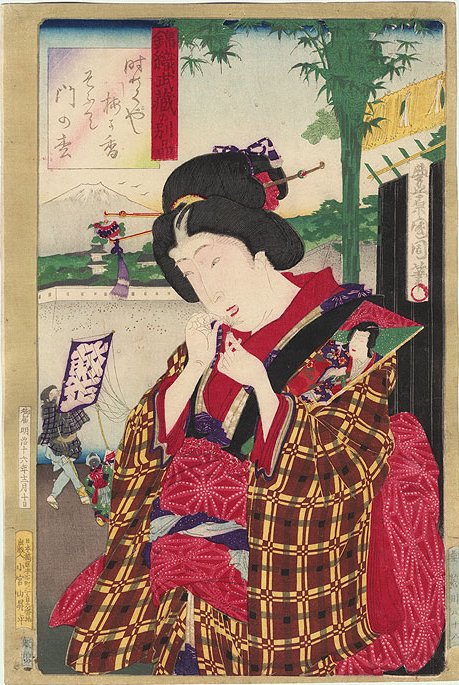| |
Kunichika
|

'Beauty
at New Year's'
Series: Newly Woven Brocades: Beauties of Musashi
("Nishiki-ori Musashi no Beppin", "錦織武蔵の 別品")
1883
Series: Newly Woven Brocades: Beauties of Musashi
("Nishiki-ori Musashi no Beppin", "錦織武蔵の 別品")
1883
Comment - Attractive scene of a beauty
at New Year's, looking shyly down with a smile as she touches
the tips of a tiny feathered shuttlecock in her hands. A
hanetsuki racket decorated with a kabuki actor's portrait is
tucked under her arm, ready for a traditional holiday game
similar to badminton. Behind her, two boys ready for flying a
traditional Edo kite with white kanji characters ("敕正" name?)
on blue background (Kanji kite, "ji tako", "字凧"), the older
child lifting the kite up. Mt. Fuji can be seen in the
distance beyond the palace walls, and a bamboo decoration
frames the scene at right. The decoration hinting at a New
Year's scene. The title maybe in the unread square cassette.
Slight bokashi shading in the sky. The red rectangular cassette upper left contains the title of the woodblock, the adjoining sqare contains a poem (unread)
Series - Newly Woven Brocades: Beauties of Musashi ("Nishiki-ori Musashi no Beppin", " 錦織武蔵の別品"), title in the red cassette. "Musashi" ("武蔵") is a reference to the Musashi plain, which extended across Edo (modern Tokyo). References to the Musashi plain emerged in early Japanese poetry. The theme was taken up by ukiyo-e print designers, thus becoming strongly linked to Edo's cultural indentity. In 'Newly woven brocades' half-to three-quarter length portraits of individual women from the capital are placed in both interior and exterior settings. The prints are depicting contemporary bijin, within landscapes and the interiors using single point perspective introduced to Japan by the Dutch in the 17th century and in wide use in Japan by the late 18th century.
Artist - see Biography
Signature - "Toyohara Kunichika hitsu" ("豊原国周筆", "drawn by Toyohara KUNICHIKA") (white cassette, upper right side) with his red ring seal (Otoshidama-in 年玉印).
Publisher - Komiyama Shōbei (Shōhei) (小宮山昇平); carver Hori Nobu (彫延); both seals on left margin; (painters name at right selvage)
Image Size - 34.9 x 22.9 cm (13 3/4" x 9") plus margins as shown
Condition - single panel; nishiki-e (cloured woodblock); Vertical ôban (ôban tate-e);
Additional information - cassette, lower right margin: 画工荒川八十八 [gakō (painter) Arakawa Yasohachi (Kunichika's mother's surname, Arakawa, and the artist's given name, Yasohachi, followed by the artist's address)]
Slight bokashi shading in the sky. The red rectangular cassette upper left contains the title of the woodblock, the adjoining sqare contains a poem (unread)
Series - Newly Woven Brocades: Beauties of Musashi ("Nishiki-ori Musashi no Beppin", " 錦織武蔵の別品"), title in the red cassette. "Musashi" ("武蔵") is a reference to the Musashi plain, which extended across Edo (modern Tokyo). References to the Musashi plain emerged in early Japanese poetry. The theme was taken up by ukiyo-e print designers, thus becoming strongly linked to Edo's cultural indentity. In 'Newly woven brocades' half-to three-quarter length portraits of individual women from the capital are placed in both interior and exterior settings. The prints are depicting contemporary bijin, within landscapes and the interiors using single point perspective introduced to Japan by the Dutch in the 17th century and in wide use in Japan by the late 18th century.
Artist - see Biography
Signature - "Toyohara Kunichika hitsu" ("豊原国周筆", "drawn by Toyohara KUNICHIKA") (white cassette, upper right side) with his red ring seal (Otoshidama-in 年玉印).
Publisher - Komiyama Shōbei (Shōhei) (小宮山昇平); carver Hori Nobu (彫延); both seals on left margin; (painters name at right selvage)
Image Size - 34.9 x 22.9 cm (13 3/4" x 9") plus margins as shown
Condition - single panel; nishiki-e (cloured woodblock); Vertical ôban (ôban tate-e);
Additional information - cassette, lower right margin: 画工荒川八十八 [gakō (painter) Arakawa Yasohachi (Kunichika's mother's surname, Arakawa, and the artist's given name, Yasohachi, followed by the artist's address)]
Copyright 2008 ff: Hans P. Boehme